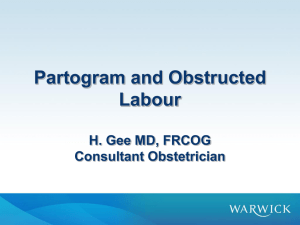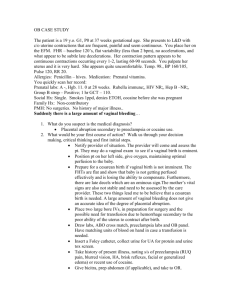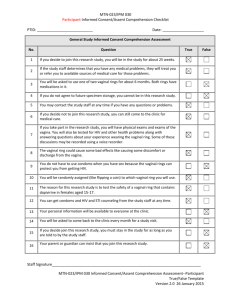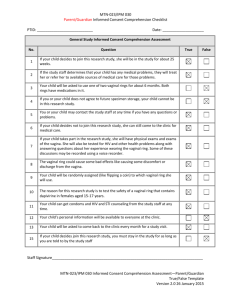Monitoring the progress of labor
advertisement
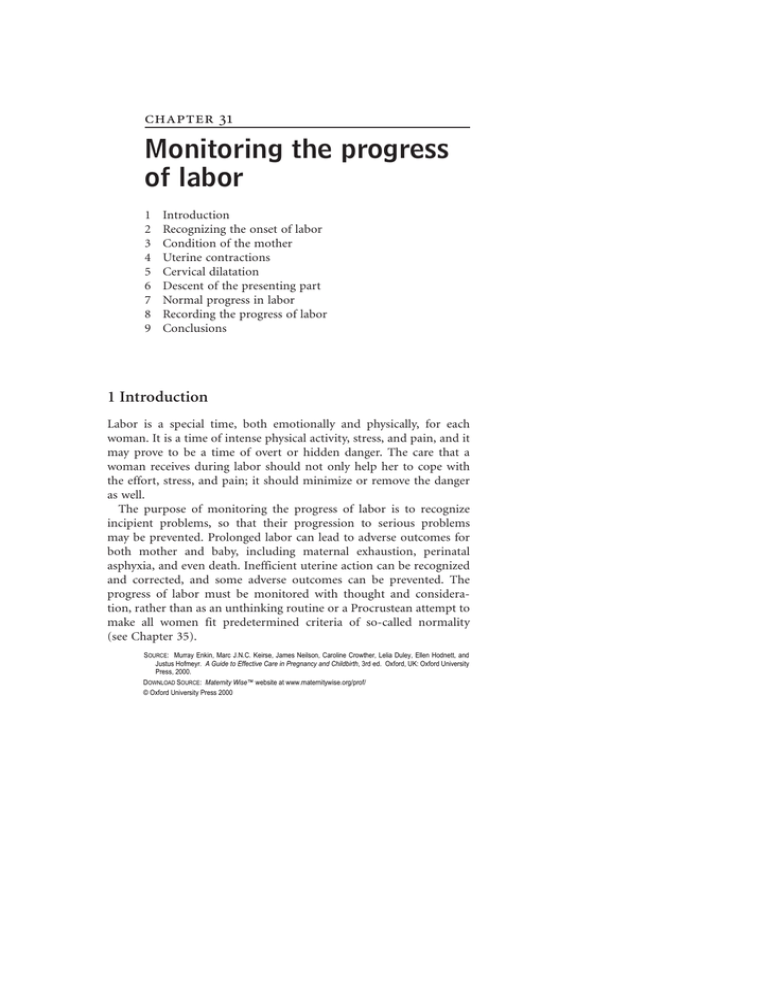
1 2 3 4 5 6 7 8 9 10 1 2 3 4 5 6 7 8 9 20 1 2 3 4 5 6 7 8 9 30 1 2 3 4 5 6 7 8111 9 40 41 Monitoring the progress of labor 1 2 3 4 5 6 7 8 9 Introduction Recognizing the onset of labor Condition of the mother Uterine contractions Cervical dilatation Descent of the presenting part Normal progress in labor Recording the progress of labor Conclusions 1 Introduction Labor is a special time, both emotionally and physically, for each woman. It is a time of intense physical activity, stress, and pain, and it may prove to be a time of overt or hidden danger. The care that a woman receives during labor should not only help her to cope with the effort, stress, and pain; it should minimize or remove the danger as well. The purpose of monitoring the progress of labor is to recognize incipient problems, so that their progression to serious problems may be prevented. Prolonged labor can lead to adverse outcomes for both mother and baby, including maternal exhaustion, perinatal asphyxia, and even death. Inefficient uterine action can be recognized and corrected, and some adverse outcomes can be prevented. The progress of labor must be monitored with thought and consideration, rather than as an unthinking routine or a Procrustean attempt to make all women fit predetermined criteria of so-called normality (see Chapter 35). SOURCE: Murray Enkin, Marc J.N.C. Keirse, James Neilson, Caroline Crowther, Lelia Duley, Ellen Hodnett, and Justus Hofmeyr. A Guide to Effective Care in Pregnancy and Childbirth, 3rd ed. Oxford, UK: Oxford University Press, 2000. DOWNLOAD SOURCE: Maternity Wise™ website at www.maternitywise.org/prof/ © Oxford University Press 2000 1 2 3 4 5 6 7 8 9 10 1 2 3 4 5 6 7 8 9 20 1 2 3 4 5 6 7 8 9 30 1 2 3 4 5 6 7 8 9 40 41 2 Recognizing the onset of labor Women usually make a diagnosis of labor by themselves, usually on the basis of painful, regular contractions. Sometimes they make the diagnosis after a show of mucus or blood, or after rupture of the membranes. Whether antenatal education for self-diagnosis of the onset of active labor decreases the need for intrapartum interventions and reduces other adverse outcomes is unknown. On admission to hospital the woman’s self-diagnosis of labor may, or may not, be confirmed by the professional staff. True labor must be differentiated from false labor. Whether or not true labor has started is one of the most important decisions to be made in labor care. Labor is, by definition, the presence of regular uterine contractions, leading to progressive effacement and dilatation of the cervix, and ultimately to the birth of the baby. While there is no difficulty in confirming the presence of labor when it is strong and well-established, the diagnosis is not always as clear-cut as this definition would suggest. To confirm or deny the diagnosis of labor in a woman self-admitted as ‘in labor’ is difficult when the cervix is uneffaced and closed. The problem may be ameliorated by the use of early-labor assessment, or triage areas, in which women who believe that they are in labor can be assessed or observed, rather than admitted (see Chapter 29). In one trial, the use of strict criteria by caregivers for the diagnosis of active labor in term pregnancy favorably affected labor outcomes by reducing the need for intrapartum oxytocics and analgesia, and the women reported greater feelings of control during labor and birth. The time of onset of labor often is not precisely known. The most convenient and most used marker of the onset of labor for women giving birth in hospital (although an arbitrary rather than a biologically correct starting point), is the time when the woman is admitted in labor. For women who plan to give birth at home, the time at which the midwife arrives (having been called by the woman) may similarly be used. This serves as a semi-objective surrogate index of the onset of labor, and is a practical starting point from which subsequent progress can be monitored. The point in labor at which a woman presents herself for admission to hospital, or asks her caregiver to attend, will vary from woman to woman. Several factors may influence this decision, including the way she feels, her expectations of labor, her experience in previous pregnancies, her anxiety about arriving too early or too late, and any complications that may have arisen. It will depend also on the advice 1 2 3 4 5 6 7 8 9 10 1 2 3 4 5 6 7 8 9 20 1 2 3 4 5 6 7 8 9 30 1 2 3 4 5 6 7 8 9 40 41 that she has been given as to how and when she should recognize herself to be in labor and when to come to the hospital, which in turn will depend on the admission policy of each maternity unit. All of these factors will affect when a woman is first seen in labor and hence, the apparent length of her labor. The timing of hospital admission may have important consequences for the progress of labor. Studies show that women who come to hospital early have more diagnoses of ‘difficult labor’ recorded, receive more intrapartum interventions, and more cesarean sections. It is unlikely that any universal ‘best’ time will be determined for asking the midwife to attend at home or for hospital admission in labor. For most women, the ‘best’ time may be when they feel that they would be happier or more comfortable in hospital or with the midwife in attendance. 3 Condition of the mother The physical and mental state, and the comfort and well-being of the woman must be just as carefully monitored during labor as the progress of contractions or the state of the cervix. The possible causes of symptoms such as nausea, dyspnea, or dizziness, should be fully assessed and treatment provided if necessary. The intensity of pain the woman experiences will determine her need for, and the timing of, pain relief. Every effort should be made to ensure that all women in labor receive continuous intrapartum support, not only from close companions, but also from caregivers specially trained to give support (see Chapter 28). Adequate attention must be paid to the woman’s physical condition. In most circumstances this will include, at least, initial assessment of her blood pressure, pulse, and temperature. Although such assessments have become traditional, there is little agreement as to how frequently they should be performed. The value, if any, of routinely repeated assessments of pulse and blood pressure in apparently normal labor is unknown. It is likely to be so small as to serve no useful purpose. In the presence of known or suspected abnormality (such as antepartum or intrapartum hemorrhage, or pre-eclampsia), such assessments should be made as frequently as necessary, or even continuously, rather than being dictated by a rigid schedule that is applied to all women. 1 2 3 4 5 6 7 8 9 10 1 2 3 4 5 6 7 8 9 20 1 2 3 4 5 6 7 8 9 30 1 2 3 4 5 6 7 8 9 40 41 4 Uterine contractions Labor is initiated, and progress maintained, by contractions of the uterus. Almost always the woman herself is aware of the contractions, their frequency, duration, and strength. These parameters can be confirmed by abdominal palpation. Self-report by the woman, supplemented by abdominal examination when required, is quite sufficient to monitor the contractions in most situations. Abdominal palpation cannot, however, accurately measure the changes in uterine pressure resulting from the contraction, and this constraint also applies to the record of uterine contractions made by an external tocodynamometer. It may provide an accurate record of the frequency and, to a lesser extent, of the duration of contractions, but not of their intensity. The limited information available from controlled trials shows no advantage to be gained from the use of an intra-uterine pressure catheter, either in the monitoring the progress of labor or in the treatment of delays in labor progress. 5 Cervical dilatation The rate of dilatation of the cervix is the most exact measure of the progress of labor. Cervical dilatation is usually estimated in centimetres, from 0 cm when the cervix is closed, to 10 cm at full dilatation. Assessment of cervical dilatation is not, however, as precise as one would like to believe. To our knowledge, no studies of either interobserver or intra-observer variation have been reported, but personal experience has shown substantial variations in estimates of dilatation by different observers in the same situation, and even by the same observer on repeat examination. There is no clear guidance from the literature as to the best time to assess the dilatation in relation to a contraction, but consistent timing of observation is probably important when assessing progress. Cervical dilatation and effacement can be assessed directly by vaginal examination or indirectly by rectal examination. Rectal examinations were advocated toward the end of the nineteenth century in the belief that, unlike vaginal examinations, they did not cause contamination of the genital tract. Several studies comparing vaginal and rectal examinations were made in the United States in the mid-1950s to 1960s; all showed a similar incidence of puerperal infection, whether 1 2 3 4 5 6 7 8 9 10 1 2 3 4 5 6 7 8 9 20 1 2 3 4 5 6 7 8 9 30 1 2 3 4 5 6 7 8 9 40 41 rectal or vaginal examinations were employed during labor. Women’s preference for vaginal rather than rectal examinations was clearly demonstrated in a randomized clinical trial. The available evidence suggests that rectal examinations have no place in monitoring the progress of labor. There is no evidence that masks should be worn when vaginal examinations are performed. Masks have not been shown to be of value during vaginal surgery or in the delivery room, so it is highly unlikely that any infections are prevented by this practice. The recommended frequency of vaginal examinations to assess the progress of cervical dilatation varies greatly among units and in the literature. This variation illustrates the lack of consensus for the optimal timing of vaginal examinations in labor. Like all assessments in labor, it would seem most sensible that care should be individualized. The number and timing of vaginal examinations should be frequent enough to permit adequate assessment of progress and to detect any problems promptly, but not more frequently than necessary to accomplish this end. 6 Descent of the presenting part If the head is presenting, its relationship to the brim of the pelvis can be determined by abdominal or vaginal examination. Descent can be estimated abdominally by assessing the amount of the baby’s head that is still above the pelvic brim. Abdominal assessment avoids the need for vaginal examination and is not influenced by the presence of a caput succedaneum or moulding. On vaginal examination, the level of the presenting part can be related to the ischial spines. Moulding of the fetal head, an important observation in following the progress of labor if cephalopelvic disproportion is suspected, can also be determined by vaginal examination. Given the complementary information that can be obtained, both abdominal and vaginal examination should be carried out before any operative delivery is undertaken (see Chapter 35). 7 Normal progress in labor Normal labor can be defined either in terms of the total length of labor or as a rate of progress of cervical dilatation (usually expressed in cm 1 2 3 4 5 6 7 8 9 10 1 2 3 4 5 6 7 8 9 20 1 2 3 4 5 6 7 8 9 30 1 2 3 4 5 6 7 8 9 40 41 per hour); the latter measure is clinically more useful, as the total length of labor can only be known in retrospect. A rate of 1 cm/hour in the active phase of labor is often accepted as the cut-off between normal and abnormal labor. The validity of this cut-off point can certainly be challenged. Many women who show slower rates of cervical dilatation proceed to normal birth. A rate of 0.5 cm/hour may be more appropriate as a lower limit for defining normal progress, but this too should be interpreted with discretion, in the context of the woman’s total well-being. 8 Recording the progress of labor When monitoring the progress of labor, recording the findings is almost as important as making the assessments. The primary reasons for doing so are to make the degree of progress readily apparent, so that problems will be recognized early, and to facilitate transfer of information to other caregivers. Several methods of recording measures of progress are in current use. A time-based diary of events permits a detailed documentation of all important maternal and fetal assessments, but the recording and inspection of such a record can be tedious. It is often difficult to follow, particularly when labor is prolonged or when there is a change of staff. A more structured representation of events and progress can facilitate early recognition of potentially correctable problems. The partogram, a structured graphical representation of the progress of labor, has been adopted in many units throughout the world and is considered by many as a necessary tool in the management of labor. In addition to the graph depicting cervical dilatation and descent of the presenting part in relation to time, space can be provided for notes on the frequency of contractions, degree of moulding, medications, the fetal heart rate, and other important events. With the use of a partogram, the progress of labor can be seen at a glance on one sheet of paper, failure to progress can be recognized readily, and the writing of lengthy descriptions can be avoided. It is simple to use, a practical teaching aid, and is an efficient means of exchange of technical information about labor progress between teams of caregivers. On the other hand, too much reliance on partograms, and especially on strict protocols of action related to partogram patterns, can be an agent for regimenting labor rather than for caring for the woman in labor. 1 2 3 4 5 6 7 8 9 10 1 2 3 4 5 6 7 8 9 20 1 2 3 4 5 6 7 8 9 30 1 2 3 4 5 6 7 8 9 40 41 Observational studies have reported improved pregnancy outcomes with the use of a partogram, with reduced risk of perinatal death and prolonged labor. Only recently has there been any controlled evaluation of the use of the partogram during labor. In a large multicenter trial in SE Asia, conducted by the World Health Organization, the use of the partogram with an agreed labor-management protocol reduced the incidence of prolonged labor, the proportion of labors requiring augmentation, the intrapartum stillbirth rate, and the emergency cesarean section rate. 9 Conclusions The well-being of both the mother and the fetus must be carefully monitored during labor. This monitoring does not necessarily require the use of special equipment, but it always requires careful and individualized observation. Monitoring the progress of labor requires more than the assessment of uterine contractions and dilatation of the cervix. The rate of progress must be considered in the context of the woman’s total well-being, rather than simply as a physical phenomenon. A dilatation rate of 1 cm/h in a woman who is having strong contractions and is in severe distress, is far more worrying than a rate of 0.3 cm/hour in a woman who is comfortable, walking around, drinking cups of tea, and chatting with her companions (see Chapter 35). Vaginal rather than rectal examination should be used to assess the progress of labor, but no more often than deemed necessary. Slow progress should alert caregivers to the possibility of abnormal labor, but should not automatically result in intervention. The use of a partogram to graphically represent the progress of labor is beneficial. Sources Effective care in pregnancy and childbirth Crowther, C., Enkin, M.W., Keirse, M.J.N.C. and Brown, I., Monitoring the progress of labour. Cochrane Library Buchmann, E.J., Gulmezoglu, A.M. and Nikodem, V.C., Partogram for assessing the progress of labour [protocol]. 1 2 3 4 5 6 7 8 9 10 1 2 3 4 5 6 7 8 9 20 1 2 3 4 5 6 7 8 9 30 1 2 3 4 5 6 7 8 9 40 41 Hodnett, E., Caregiver support for women during childbirth. Lauzon, L. and Hodnett, E., Antenatal education for self-diagnosis of the onset of active labour at term. Caregivers’ use of strict criteria for diagnosing active labour in term pregnancy. Other sources World Health Organization Maternal Health and Safe Motherhood Program (1994). World Health Organization partograph in the management of labour. Lancet, 343, 1399–404.


